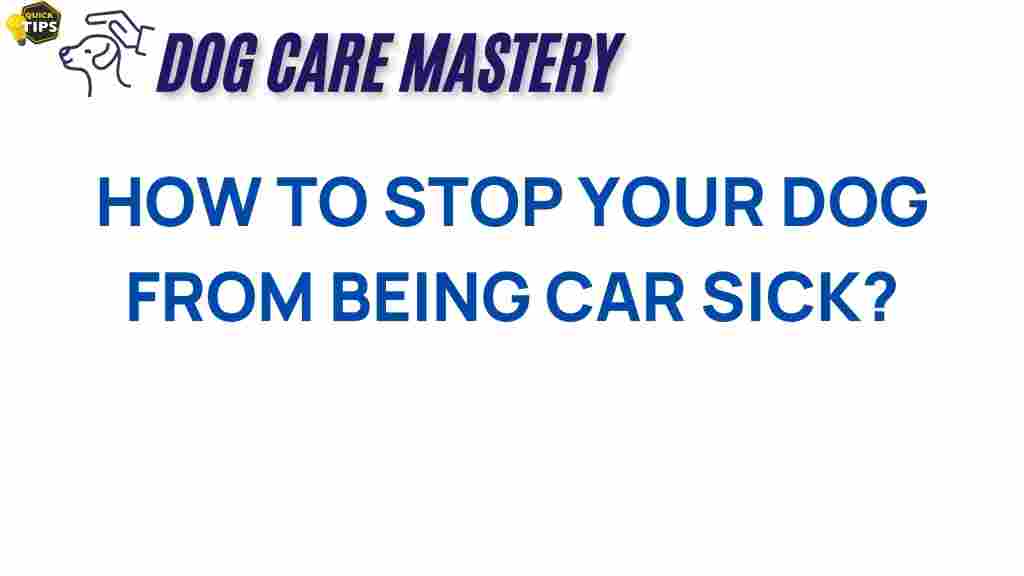Understanding Dog Car Sickness: Causes and Symptoms
Dog car sickness is a common issue that many pet owners face, especially during long trips or family vacations. Just like humans, dogs can experience motion sickness, which can lead to discomfort, anxiety, and even vomiting. Understanding what causes dog car sickness and recognizing its symptoms are the first steps to finding effective solutions.
What Causes Dog Car Sickness?
Several factors can contribute to dog car sickness, including:
- Inner Ear Development: Puppies have underdeveloped inner ears, which can lead to balance issues when the vehicle is in motion.
- Fear and Anxiety: Some dogs may associate car rides with negative experiences, leading to anxiety and sickness.
- Motion Sensitivity: Just like humans, some dogs are more sensitive to motion and may struggle to adapt to the car’s movement.
- Unfamiliar Environments: New sights, sounds, and smells can overwhelm dogs, making them feel nauseous.
Recognizing the Symptoms of Dog Car Sickness
Identifying the signs of dog car sickness is crucial for timely intervention. Common symptoms include:
- Excessive drooling
- Vomiting
- Restlessness and pacing
- Whining or barking
- Loss of appetite
If you notice your dog exhibiting these symptoms, it’s essential to address the issue promptly to ensure a pleasant travel experience.
Solutions That Work for Dog Car Sickness
Now that we understand the causes and symptoms of dog car sickness, let’s explore effective solutions. Here’s a step-by-step process to help alleviate your dog’s discomfort during car rides.
Step 1: Prepare Your Dog for the Journey
Preparation is key to reducing the chances of dog car sickness. Here are some strategies:
- Get Your Dog Used to the Car: Before embarking on long trips, take your dog on short drives to help them acclimate to the vehicle.
- Use a Crate or Seatbelt Harness: A secure environment can help reduce anxiety and motion sickness. Consider using a crash-tested dog crate or a seatbelt harness designed for pets.
- Provide Comfort Items: Bring along your dog’s favorite blanket or toy to help them feel more relaxed in the car.
Step 2: Timing and Feeding
When it comes to dog car sickness, the timing of your dog’s meals can make a significant difference:
- Avoid Feeding Before Travel: It’s advisable to not feed your dog for at least three to four hours before the journey. This can help minimize the chance of vomiting.
- Light Snacks: If your dog is prone to car sickness, consider giving them light snacks instead of a full meal before traveling.
Step 3: Create a Calm Environment
Reducing anxiety is crucial to managing dog car sickness. Here are some tips:
- Limit Distracting Movements: Ensure your dog has ample space in the car without being thrown around during sudden stops.
- Use Calming Aids: Consider using calming sprays or collars infused with natural ingredients such as lavender to create a soothing atmosphere.
- Keep Windows Closed: While fresh air can help, open windows can also lead to overwhelming smells. It’s best to keep them partially closed.
Step 4: Consider Medication
If your dog continues to struggle with car sickness despite your best efforts, consult your veterinarian about medication options. Some common medications include:
- Antihistamines: These can help reduce motion sickness symptoms.
- Prescription Medications: Your vet may prescribe medications specifically designed for motion sickness in dogs.
Always follow your vet’s guidance regarding dosage and frequency.
Troubleshooting Tips for Persistent Dog Car Sickness
In some cases, despite your efforts, dog car sickness may persist. Here are some troubleshooting tips to consider:
Evaluate Your Travel Method
Sometimes, the type of travel can influence your dog’s comfort:
- Choose the Right Vehicle: Some vehicles provide a smoother ride than others. If possible, opt for a vehicle with a more comfortable ride.
- Drive Smoothly: Avoid sudden stops or sharp turns that can exacerbate motion sickness.
Monitor Your Dog’s Behavior
Keep a close eye on your dog during travels:
- Watch for Signs of Anxiety: If your dog seems anxious, consider taking breaks more frequently to allow them to stretch and relieve stress.
- Provide Positive Reinforcement: Reward your dog with treats and praise during and after the trip to create positive associations with car rides.
Consult a Professional Trainer
If anxiety is a significant factor, you may benefit from working with a professional dog trainer. They can provide tailored strategies to help your dog overcome their fear of car travel.
Conclusion: Making Car Rides Enjoyable for Your Dog
Dog car sickness can be a challenging issue, but with the right strategies, you can help your furry friend enjoy car rides instead of dreading them. By understanding the causes, preparing adequately, and implementing effective solutions, you can ensure that every trip is a positive experience for both you and your dog.
Remember, patience is key. It may take time for your dog to adjust, but your efforts will be rewarded with more enjoyable travels together. For more resources and tips on dog care, feel free to check out our pet care blog.
For additional information on dog health and wellness, consider visiting the American Kennel Club, a trusted source for dog owners.
This article is in the category Behavior and created by dogcaremastery Team
